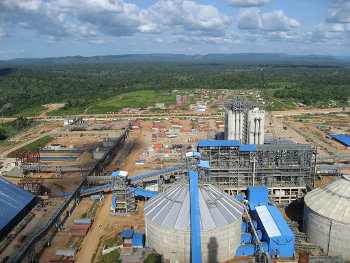Sub-Saharan Africa the world’s last cement frontier
Sub-Saharan Africa (SSA) is the world’s last cement frontier, currently with a supply deficit of some 5 million tons per annum.

Dangote's Obajana cement plant in Nigeria
With stronger economic growth and the world’s highest cement prices, this gap is rapidly being filled and by 2013, we believe the sub continent’s requirements will be fully satisfied, on the completion of significant investment into capacity expansion, which we calculate to be in the region of 16 million tonnes. It must be noted, however, that the demand/supply balance is intrinsically related to the level of development of the financial markets, hence, while proposed investment more than adequately cover the estimated current deficit, the latter is a moving target. Also, cement prices in SSA are, at the top end, some 200% higher than emerging and developed countries. The expected drop in prices resulting from the eradication of supply bottlenecks should significantly impact on demand. Importantly, a lower cement price will reduce of the cost implications addressing SSA’s infrastructural deficit.
The demand side too is looking positive. Improved political stability, fiscal management and lower sovereign debt levels have availed funds for capital investment, and post the 2008 commodity price shock, economic fundamentals, for the larger part, are improving. According to the IMF, in the last five years, real GDP growth in Sub-Saharan Africa has grown by an average rate of 5.8% while population growth has averaged 1.75% over the same period. In effect, per capita incomes are increasing, and Africans, on the whole are getting wealthier, albeit from a low base. Rising per capita incomes can clearly be seen in increasing mobile penetration rates, beverage and FMCG consumption patterns.
Governments have been prioritising increasingly larger portions of their budgets on growing their infrastructural capacity in order to increase trade and ease unemployment, and donors too have played an important role. This is clearly visible in Angola, Botswana, Nigeria, Rwanda, South Africa and Uganda, where government sponsorship has been the main catalyst for infrastructural development. In Morocco, Tunisia, Algeria and Egypt, modelled on similar projects in the Arab Emirates, the creation of new multi-million dollar cities has been the focus.
Also to play an increasingly important role, will be Africa’s newest oil producing countries, Ghana and Uganda. Not to mention the creation of a 54th African state on the secession of Southern Sudan, which marked the end of Africa’s longest running civil war. In the latter for example, a whole new country has to be built, all to be funded by its share of the oil revenues.
Geo-political forces have also been at play with China’s strategic focus to dominate Africa’s resources in exchange for long term financing packages, being the predominant driving force. Across the continent and in exchange for resource wealth, the Chinese Dragon has blazed a trail of infrastructure projects including roads, bridges, dams, airports, skyscrapers, and by a wide margin, Sinoma is the largest cement plant builder on the continent (currently installing around 15 million tonnes by 2013).
Deepening banking penetration rates, increasing disintermediation and greater access to bond markets and international credit lines are also having a positive role on the construction industry. South Africa and North Africa remain the most developed financial blocs, however, up and coming financial markets are clearly visible in East Africa with some bright spots in Southern Africa (Botswana and Namibia).
Largely, SSA remains essentially a cash economy and access to long term consumer mortgage products has yet to develop meaningfully. The proposed introduction of a common monetary union in East Africa, and possibly Southern Africa adopting the Rand, will have a significant impact on the development of financial markets and particularly on the cost of funding.
Nontando Zunga and Anthony Lopes-Pinto are analysts at Imara Securities. This article is an extract of Imara’s African Cement Report 2011

